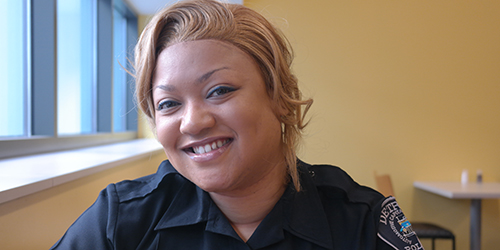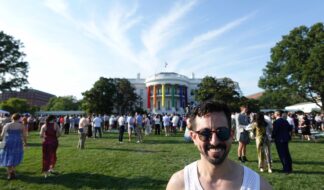BY AJ TRAGER

Dani Woods, the LGBT liaison for the Detroit Police Department. Photo: AJ Trager
DETROIT – Historically, the LGBT community has had a long and sometimes very violent track record with law enforcement. Throughout the United States, laws requiring people wear two to three items of gender appropriate clothing were common all the way up until the 1960s. These laws most significantly impacted LGBT people, particularly transgender and gender non-conforming individuals. This version of policing gender and sexuality often resulted in police entrapment, police harassment, police raids, violent arrests, beatings, sexual assaults and corrective rape. Perhaps the most famous police harassment event was the one that led to the Stonewall riots in June 1969 in NYC, n event often seen as the tipping point TO the modern LGBT rights movement.
Today Michigan enforces gender and sexuality by maintaining the assumption that heterosexual and cis-gender people are better than lesbian, gay, bisexual or transgender individuals. With marriage equality currently absent in the state and no state laws protecting LGBT individuals, discrimination against LGBT people is perfectly legal despite strong efforts from advocacy and ally groups to educate and change this.
"These laws are civil in nature and they affect every aspect of our lives. They collaterally result in criminal consequences for the most targeted and marginalized among us," said Yvonne Siferd at a recent criminal justice symposium held at the University of Michigan-Dearborn. Siferd is director of victim services at Equality Michigan. "This vehement belief in the superiority of heterosexual relationships is heavily rooted in our insistence on the gender binary and underlines our belief that we are entitled to police transgender bodies as well as queer people's sexuality, criminally and socially."
In the U.S., laws born out of religious doctrine often prohibited specific sex acts such as sodomy or "un-natural" acts. Even though it was illegal for a married couple to commit sodomy or have oral intercourse too, the effect was solely to police gay and sometimes lesbian sexuality. In the early years of the country, the punishment for these acts was sometimes death. These two laws are still on the books in Michigan despite being struck down in 2003 by the U.S. Supreme Court.
Thirty-four years after Stonewall, in 2003, the Wayne County Sheriff's Department raided the Power Plant, a private LGBT club in Detroit, whose members were primarily black gay men, lesbians and trans women. Between 50 and 100 officers entered the club and over 350 people were handcuffed, forced to lie down on the floor and detained for up to 12 hours. They were left to sit in their and others' urine and waste, and some were kicked in the head and back, slammed into walls and verbally assaulted. Officers on the scene were heard saying things like, 'It's a bunch of fags' and, 'Those fags in here make me sick.' Like the Stonewall police officers, these officers claimed to be enforcing building and liquor codes.
Discrimination, harassment and abuses like the one at the Power Plant undermine effective policing by weakening community trust, reducing reporting of crimes by victims in the LGBT community and challenging law enforcement's ability to effectively meet the needs of members of their communities.
Nationwide Reports And Statistics
According to the 2013 FBI Hate Crimes statistics, LGBT communities were the second most impacted population for the second year in a row. First place went to people where the hate crime involved their race, the third their religion. These numbers are actually lower than what was reported by the National Coalition of Anti-Violence Programs, which reported 2,001 victims and survivors of hate violence in 2013 compared to the FBI's statistic of 1,402. The FBI relies on local law enforcement agencies to report hate crimes and keep up with the federal law, however, the NCAVP relies on the reporting from LGBT community organizations. LGBT survivors of hate crimes prefer to report to LGBT organizations over law enforcement.
"Given the LGBTQ community's past and present issues with law enforcement, it isn't all that surprising," Siferd said. "Another reason for the discrepancy is the ignorance and bias of law enforcement regarding LGBTQ communities, particularly when it comes to trans issues. There is often a culture of victim blaming. 'If you didn't act like that,' or, 'Maybe you were asking for it by dressing like that.' There is also a significant lack of training about LGBT people, culture and issues for law enforcement."
A recent 2015 report released by the Williams Institute at UCLA School of Law documents ongoing and pervasive discrimination and harassment by law enforcement of the LGBT community, especially among LGBT people of color and transgender individuals.
Key findings from the report have found that more than one-fifth of LGBT people who interacted with police reported encountering hostile attitudes from officers and 14 percent reported verbal assault by the police. Nearly half, 48 percent, of the LGBT violence survivors who interacted with police reported that they had experienced police misconduct, including unjustified arrest, use of excessive force and entrapment. Forty-six percent of transgender respondents reported being uncomfortable seeking police assistance, 22 percent reported that they had been harassed by law enforcement because of bias and 6 percent reported having been physically assaulted by an officer.
"Many law enforcement officers do not understand transgender people at all," said Rachel Crandall, director of Transgender Michigan. "Very often transgender people are treated like they are trying to hide something."
To address such discrimination, President Obama's Task Force on 21st Century Policing issued recommendations to build stronger and more collaborative relationships between law enforcement and the communities they serve.
"Bringing gender and sexuality based experiences of violence by the hands of the law enforcement into the center of our conversations around criminal justice is important. It shows that gender and sexuality are a central axis on which policing takes place both alongside and in service of race and poverty based policing. In other words, the kinds of gender and sexuality based violence by law enforcement is not an isolated instance; it's not a rogue cop," Andrea Ritchie said. "It's fundamental to the institution and history of policing."
Ritchie is a police misconduct attorney and organizer from New York City. She is co-author of "Queer (In)Justice: The Criminalization of LGBT People in the United States," and was an expert consultant and lead researcher for Amnesty International's 2005 report, "Stonewalled: Police Abuse and Misconduct Against Lesbian, Gay, Bisexual and Transgender People in the United States."
"Sometimes the aggression is more subtle and it's more about perceiving someone's gender non-conformity, not being able to put them in a box, someone identifying with a different box than the one they (the police officer) thought they should be in or acting in a way that the police doesn't think a woman should act. It is then subconsciously framed as suspicious or disorderly. And there is so much about policing that is about guts or how you feel about something or someone. And that's how policing gender happens," Ritchie said.
That is where Dani Woods comes in.
Dani Woods
The Williams Institute report singled out Michigan as one of four areas in the country that is training police departments in sensitivity trainings and LGBT awareness, focused on reducing police discrimination and harassment of the LGBT community.
"People tend to tense up when they see the uniform, and they know you're an officer. They throw up the defensive wall," said Dani Woods, the LGBT liaison for the Detroit Police Department.
Woods is a member of the LGBT community and lives in Detroit with her wife. They met in 2005 in the Eastern District, which now consists of the 7th and 9th Districts, and have collaboratively served the force for over 20 years.
"When I was trying to get this position up and running, I was talking to a lot of deaf ears. Nobody really wants to 'deal with it' (the LGBT issue). It is so sensitive that people didn't really want to come near or touch," Woods said.
Many of the cases that the department faces are LGBT related. Woods worked closely with Commander Chuck Wilson and Chief Chester Logan to establish a LGBT liaison position. When Chief James Craig took over for Logan in May of 2013, he made sure that the liaison position at the DPD was a key player in the department.
"He is supportive and very passionate about the community," Woods said. "That opened so many avenues. He has an open door policy, but if someone has an issue, he says, 'Come see me,' and I love that. It's awesome that he's so attentive to the LGBT community."
Woods personally handled the hate crime attack that happened during Motor City Pride in 2014, where a young black man named Christin Howard was beaten by a group of individuals. She also worked closely with other members of the force to bring justice for the body of the trans woman found in Palmer Park last year.
Woods says that her biggest fight is getting people who are victimized to come forward. Some, because they've participated in certain illegal activities like prostitution, feel that they won't be treated fairly by the police.
"I just want to say, 'You're a victim. Something happened to you. Nobody deserves that,'" Woods said. "I can't make them make a statement, and that's one of the hardest parts of my job. Because they are already in a box, they already had their guards up about past interactions with the police or are just feeling as if, 'Because I'm gay, they aren't going to take it seriously.'"
LGBT Police Training In Detroit
In a collaboration between Jay Kaplan of the ACLU and Equality Michigan, sensitivity and LGBT training has begun for one supervisor and two public officers in precincts across Detroit. Around 13 percent of the DPD has gone through LGBT trainings, Woods says, and attributes the small number to lack of general LGBT knowledge within the force when she was first hired in as the liaison. Woods hopes to get the whole department trained by 2016.
"At the beginning, everybody's face is turned up and you can see that they don't want to be there. But it's not just because it's LGBT training, it's because it's hard to get police officers to go to trainings," said Woods.
The DPD goes through what they call a 40-hour block, a week long training that every officer attends annually which involves culture, diversity, legal updates, defensive tactics, the gun range and other activities.
The sensitivity training gives the officers a lot of background of what LGBT means, what the community has gone through, what it's trying to evolve into, what it's like to be LGBT in today's society and provides a description on identities and life experiences. Woods addresses preferred gender pronouns and gender roles in same-sex partnerships and how in LGBT relationships the more masculine presenting partner isn't always the dominant one.
"I take what I know from Equality Michigan, and that's my LGBT half, and then I have to transfer it to my blue half and explain it to the officers. Some understand and carry on; others understand but don't agree. It's going to be sticky until it becomes the norm," Woods said. "We're not robots, but what we're taught is what we're taught. And sometimes gray doesn't fit in. Sometimes it's this or that. Sometimes it's not a possibility for this or that. And some people are stuck in that."
Woods opens her trainings by saying she doesn't want to change the officers and instead is focused on opening their eyes to identities that are evolving in their communities.
"Everybody has an Uncle Larry or an Auntie Sue in their family," Woods said. "Some choose to talk about it, some don't. But at the end of the training, everybody expresses that much of the information was new to them. They get excited learning something new."
Williams Institute Recommendations
The Williams Report suggests policy recommendations for state and city governments in order to improve LGBT and law enforcement relationships, including: non-discrimination policies and zero tolerance harassment policies, LGBT trainings, outreach and liaisons to the LGBT community, citizens complaint review boards and prohibition of discrimination against law enforcement personnel.
The President's Task Force On Policing, at the urging of dozens of women's and LGBT organizations, gave some answers and offered some key recommendations to local law enforcement that would begin to address profiling, not just on the basis of race, religion and ethnicity, but also on the basis of gender identity and sexual orientation. It would include a ban on tools of profiling that are particularly used against women and LGBT people of color, like the use of condoms as evidence of intent to engage in prostitution related offenses. It's also recommended that departments adopt policies for interactions with LGBT folks to eliminate another kind of sexual violence, like when a police officer cannot decide what gender someone is and they search to determine anatomy.
"Coded laws have been used to effectively police gender and sexuality – disorderly conduct, for example. Here in Detroit it was the annoying persons ordinance that was favored by police in their un-officially named 'Bag-a-fag' operation; that was a sting operation that targeted gay men up until the 21st century," Siferd said. "When someone dares to step outside of what is considered the norm for men and women of the time, and that does change, we punish them socially – sometimes criminally – and readily excuse and rationalize discrimination."










